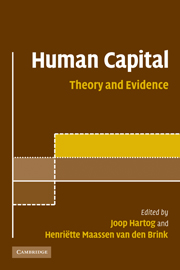Book contents
- Frontmatter
- Contents
- List of figures
- List of tables
- Notes on contributors
- Prologue
- Part I Measuring the benefits from human capital
- 1 What should you know about the private returns to education?
- 2 The social returns to education
- 3 Returns to training
- 4 Human capital and entrepreneurs
- 5 The effects of education on health
- 6 Are successful parents the secret to success?
- Part II Applying and extending the human capital model
- Part III Policy interventions
- Epilogue: some reflections on educational policies
- A note on econometrics
- Index
- References
2 - The social returns to education
Published online by Cambridge University Press: 22 September 2009
- Frontmatter
- Contents
- List of figures
- List of tables
- Notes on contributors
- Prologue
- Part I Measuring the benefits from human capital
- 1 What should you know about the private returns to education?
- 2 The social returns to education
- 3 Returns to training
- 4 Human capital and entrepreneurs
- 5 The effects of education on health
- 6 Are successful parents the secret to success?
- Part II Applying and extending the human capital model
- Part III Policy interventions
- Epilogue: some reflections on educational policies
- A note on econometrics
- Index
- References
Summary
Introduction
The most frequently estimated relationship in labour economics is the one between wages and education using micro data on working individuals. The general finding is that an additional year of education increases wages by 5–15%. The figure is at the lower end for egalitarian countries such as the Netherlands and Sweden and at the upper end for many developing countries. The general consensus is that such an interval estimate quite well resembles the causal effect of education on wages, i.e. the private return to education (cf. chapter 1).
Is the estimated private return averaged over individuals a good indicator of the social return to education? Two conditions need to be fulfilled. First, the estimated private wage return needs to be equal to the effect of education on productivity. This is not the case if, for instance, institutions compress the wage structure or if education is just a signal of ability to employers. Second, there should be no (non-internalized) externalities to education. Education externalities exist if the education level of others affects the productivity of the individual. We may here differentiate between static externalities, when education has a one-time effect on output (Lucas, 1988), and dynamic externalities, where a higher education level makes the economy grow faster, perhaps because more human capital increases the number of innovations (Romer, 1990), or makes it easier to imitate technologies developed by others (Nelson and Phelps, 1966). There are also effects of education on outcomes other than productivity.
- Type
- Chapter
- Information
- Human CapitalAdvances in Theory and Evidence, pp. 21 - 37Publisher: Cambridge University PressPrint publication year: 2007
References
- 4
- Cited by



